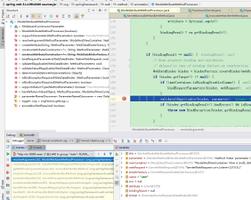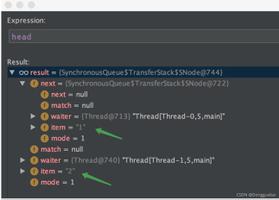java中ThreadPool的介绍和使用

文章目录
- Thread Pool简介
- Executors, Executor 和 ExecutorService
- ThreadPoolExecutor
- ScheduledThreadPoolExecutor
- ForkJoinPool
java中ThreadPool的介绍和使用
Thread Pool简介
在Java中,threads是和系统的threads相对应的,用来处理一系列的系统资源。不管在windows和linux下面,能开启的线程个数都是有限的,如果你在java程序中无限制的创建thread,那么将会遇到无线程可创建的情况。
CPU的核数是有限的,如果同时有多个线程正在运行中,那么CPU将会根据线程的优先级进行轮循,给每个线程分配特定的CPU时间。所以线程也不是越多越好。
在java中,代表管理ThreadPool的接口有两个:ExecutorService和Executor。
我们运行线程的步骤一般是这样的:1. 创建一个ExecutorService。 2.将任务提交给ExecutorService。3.ExecutorService调度线程来运行任务。
画个图来表示:
下面我讲一下,怎么在java中使用ThreadPool。
Executors, Executor 和 ExecutorService
Executors 提供了一系列简便的方法,来帮助我们创建ThreadPool。
Executor接口定义了一个方法:
public interface Executor { /**
* Executes the given command at some time in the future. The command
* may execute in a new thread, in a pooled thread, or in the calling
* thread, at the discretion of the {@code Executor} implementation.
*
* @param command the runnable task
* @throws RejectedExecutionException if this task cannot be
* accepted for execution
* @throws NullPointerException if command is null
*/
void execute(Runnable command);
}
ExecutorService继承了Executor,提供了更多的线程池的操作。是对Executor的补充。
根据接口实现分离的原则,我们通常在java代码中使用ExecutorService或者Executor,而不是具体的实现类。
我们看下怎么通过Executors来创建一个Executor和ExecutorService:
Executor executor = Executors.newSingleThreadExecutor(); executor.execute(() -> log.info("in Executor"));
ExecutorService executorService= Executors.newCachedThreadPool();
executorService.submit(()->log.info("in ExecutorService"));
executorService.shutdown();
关于ExecutorService的细节,我们这里就多讲了,感兴趣的朋友可以参考之前我写的ExecutorService的详细文章。
ThreadPoolExecutor
ThreadPoolExecutor是ExecutorService接口的一个实现,它可以为线程池添加更加精细的配置,具体而言它可以控制这三个参数:corePoolSize, maximumPoolSize, 和 keepAliveTime。
PoolSize就是线程池里面的线程个数,corePoolSize表示的是线程池里面初始化和保持的最小的线程个数。
如果当前等待线程太多,可以设置maximumPoolSize来提供最大的线程池个数,从而线程池会创建更多的线程以供任务执行。
keepAliveTime是多余的线程未分配任务将会等待的时间。超出该时间,线程将会被线程池回收。
我们看下怎么创建一个ThreadPoolExecutor:
ThreadPoolExecutor threadPoolExecutor = new ThreadPoolExecutor(1, 1, 0L, TimeUnit.MILLISECONDS,
new LinkedBlockingQueue<Runnable>());
threadPoolExecutor.submit(()->log.info("submit through threadPoolExecutor"));
threadPoolExecutor.shutdown();
上面的例子中我们通过ThreadPoolExecutor的构造函数来创建ThreadPoolExecutor。
通常来说Executors已经内置了ThreadPoolExecutor的很多实现,我们来看下面的例子:
ThreadPoolExecutor executor1 = (ThreadPoolExecutor) Executors.newFixedThreadPool(2);
executor1.submit(() -> {
Thread.sleep(1000);
return null;
});
executor1.submit(() -> {
Thread.sleep(1000);
return null;
});
executor1.submit(() -> {
Thread.sleep(1000);
return null;
});
log.info("executor1 poolsize {}",executor1.getPoolSize());
log.info("executor1 queuesize {}", executor1.getQueue().size());
executor1.shutdown();
上的例子中我们Executors.newFixedThreadPool(2)来创建一个ThreadPoolExecutor。
上面的例子中我们提交了3个task。但是我们pool size只有2。所以还有一个1个不能立刻被执行,需要在queue中等待。
我们再看一个例子:
ThreadPoolExecutor executor2 = (ThreadPoolExecutor) Executors.newCachedThreadPool();
executor2.submit(() -> {
Thread.sleep(1000);
return null;
});
executor2.submit(() -> {
Thread.sleep(1000);
return null;
});
executor2.submit(() -> {
Thread.sleep(1000);
return null;
});
log.info("executor2 poolsize {}", executor2.getPoolSize());
log.info("executor2 queue size {}", executor2.getQueue().size());
executor2.shutdown();
上面的例子中我们使用Executors.newCachedThreadPool()来创建一个ThreadPoolExecutor。 运行之后我们可以看到poolsize是3,而queue size是0。这表明newCachedThreadPool会自动增加pool size。
如果thread在60秒钟之类没有被激活,则会被收回。
这里的Queue是一个SynchronousQueue,因为插入和取出基本上是同时进行的,所以这里的queue size基本都是0.
ScheduledThreadPoolExecutor
还有个很常用的ScheduledThreadPoolExecutor,它继承自ThreadPoolExecutor, 并且实现了ScheduledExecutorService接口。
public class ScheduledThreadPoolExecutor extends ThreadPoolExecutor
implements ScheduledExecutorService
我们看下怎么使用:
ScheduledExecutorService executor = Executors.newScheduledThreadPool(5); executor.schedule(() -> {
log.info("Hello World");
}, 500, TimeUnit.MILLISECONDS);
上面的例子中,我们定义了一个定时任务将会在500毫秒之后执行。
之前我们也讲到了ScheduledExecutorService还有两个非常常用的方法:
- scheduleAtFixedRate - 以开始时间为间隔。
- scheduleWithFixedDelay - 以结束时间为间隔。
CountDownLatch lock = new CountDownLatch(3);
ScheduledExecutorService executor2 = Executors.newScheduledThreadPool(5);
ScheduledFuture<?> future = executor2.scheduleAtFixedRate(() -> {
log.info("in ScheduledFuture");
lock.countDown();
}, 500, 100, TimeUnit.MILLISECONDS);
lock.await(1000, TimeUnit.MILLISECONDS);
future.cancel(true);
ForkJoinPool
ForkJoinPool是在java 7 中引入的新框架,我们将会在后面的文章中详细讲解。 这里做个简单的介绍。
ForkJoinPool主要用来生成大量的任务来做算法运算。如果用线程来做的话,会消耗大量的线程。但是在fork/join框架中就不会出现这个问题。
在fork/join中,任何task都可以生成大量的子task,然后通过使用join()等待子task结束。
这里我们举一个例子:
static class TreeNode { int value;
Set<TreeNode> children;
TreeNode(int value, TreeNode... children) {
this.value = value;
this.children = Sets.newHashSet(children);
}
}
定义一个TreeNode,然后遍历所有的value,将其加起来:
public class CountingTask extends RecursiveTask<Integer> { private final TreeNode node;
public CountingTask(TreeNode node) {
this.node = node;
}
@Override
protected Integer compute() {
return node.value + node.children.stream()
.map(childNode -> new CountingTask(childNode).fork()).mapToInt(ForkJoinTask::join).sum();
}
}
下面是调用的代码:
public static void main(String[] args) { TreeNode tree = new TreeNode(5,
new TreeNode(3), new TreeNode(2,
new TreeNode(2), new TreeNode(8)));
ForkJoinPool forkJoinPool = ForkJoinPool.commonPool();
int sum = forkJoinPool.invoke(new CountingTask(tree));
}
本文的例子请参考https://github.com/ddean2009/learn-java-concurrency/tree/master/threadPool
更多教程请参考 flydean的博客
以上是 java中ThreadPool的介绍和使用 的全部内容, 来源链接: utcz.com/z/391742.html







